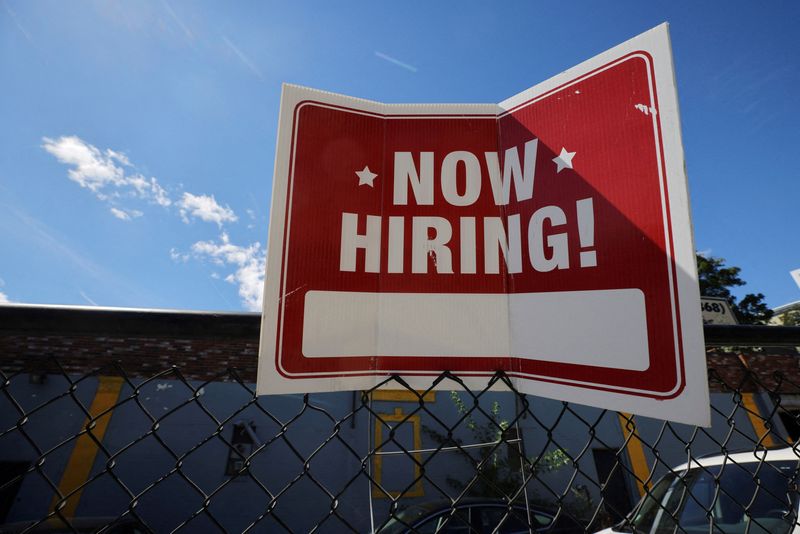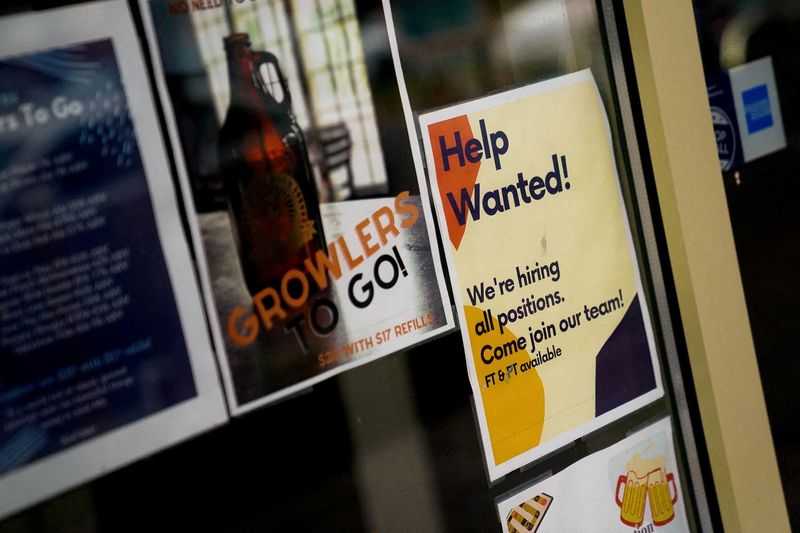By Howard Schneider and Ann Saphir
WASHINGTON (Reuters) -U.S. employers in September turned their back on Federal Reserve officials who have been expecting job growth to cool, adding 336,000 positions in a return to the fevered hiring seen during the coronavirus pandemic and potentially bolstering the case for another interest rate increase.
Upward revisions to the July and August job totals showed stronger job gains in those months as well, to the tune of 119,000 additional positions, enough to turn what had seemed like a slowdown in hiring into an analytical headache for the U.S. central bank.
Investors only slightly boosted bets that the Fed will lift the target federal funds rate by another quarter of a percentage point to the 5.50%-5.75% range by the end of this year, as economists noted that wage growth remained muted and upcoming inflation data was expected to show continued slowing.
The Fed will hold its next policy meeting on Oct. 31-Nov. 1.
"Payroll growth was impressive in September, but the underlying details are not as robust. Wage growth has downshifted," with average hourly earnings rising only 0.2% on a month-to-month basis, said Thomas Simons, a senior economist at Jefferies. "We do not think that this is going to sway the Fed towards a rate hike on Nov. 1, but the inflation data next week could push the scales."
But the September report still highlighted just how resilient the U.S. economy has remained in the face of the fastest Fed rate hikes in a generation. Using the central bank's rough estimate that the economy needs to generate about 100,000 new jobs each month to stay even with population growth, September's nonfarm payrolls gain finished filling the gap left when the onset of the pandemic threw millions out of work.
It left the Fed to feed on a stew of conflicting signals, with job growth speeding forward, wages remaining contained on a month-to-month basis, hiring surging in industries that have been expected to cool, but growth in the labor force providing more bodies to fill the jobs – a reason the unemployment rate remained steady at 3.8%.
Bond markets took the data to justify another jump in the interest rate demanded to buy long-term U.S. government debt, with the yield on the 30-year Treasury bond rising 10 basis points after the release of the jobs data and again breaching 5% - a level not seen since before the 2007-2009 financial crisis - before easing somewhat.
Indeed, the recent action in bond markets, coupled with signs the job market remains hot, show the sensitive moment the Fed and the economy may be approaching as the central bank tries to engineer a "soft landing" that slows inflation without fracturing employment and growth.
The possibility of that outcome, rare in recent U.S. history, has been seemingly on the rise in recent months as inflation declined even as the unemployment rate remained steady near historically low levels.
FUNDAMENTAL REEVALUATION
Fast recent rises in long-term borrowing rates, however, may pose a fresh risk, with the shifting relationship between short- and long-term yields often a precursor to recession as financing costs rise more than expected for businesses and households, and spending and investment are depressed.
Acting U.S. Labor Secretary Julie Su downplayed concerns the September employment report reflected an unsustainably strong jobs market, noting that the three-month average employment gain of just over 266,000 from July through September was far below the year-ago pace of more than 400,000.
"This is no longer ... overheated," she said. "It is strong, stable growth."
While the data may not sway the outcome of the Fed's next policy meeting, it will likely accentuate a debate over how labor markets impact inflation, and over just how much tighter financial conditions need to be given the recent swift rise in Treasury yields. The one might argue for tighter Fed policy; the other that conditions already risk growing too strict.
In a report done for Evercore ISI, John Roberts, a former top researcher at the U.S. central bank, said recent Fed economic projections indicate policymakers are in the midst of reevaluating fundamental aspects of the economy, and have seemingly concluded the U.S. can support lower levels of unemployment without inflation, but may need higher interest rates to keep prices in check due to strong underlying demand.
The challenge now is to determine whether recent moves in long-term bond yields are imposing more restraint on the economy than needed, a risky call for a central bank that does not want to throw the economy into recession, but also does not intend to leave prices or price expectations room to surge.
"It is far from clear to us that the Fed actually needs to pile on further with an additional rate increase, given the severity" of the rises in bond yields, which feed through to the rates consumers and businesses pay on mortgages and other forms of credit, said Krishna Guha, vice chairman of Evercore. "The idea that the bond market will simply adjust to a new equilibrium as opposed to run yields higher until something – the data, financial stress or the Fed – calls time on the move seems implausible, with clear and present danger of overshooting."
Economists polled by Reuters had expected job growth of only 170,000 positions in September. The breadth of hiring also countered arguments made recently by some Fed officials that job gains had become so narrowly focused on the healthcare and social assistance sector that the rest of the economy seemed weak.
The big gainer in September was the leisure and hospitality industry, which added 96,000 jobs, about 50% higher than its monthly average for the past year.
Coupled with an unexpected jump in job openings in August, the jobs report provided the sort of outcome that could shift sentiment toward higher rates given an economy that continues to surprise with above-trend growth.
The Fed held its benchmark overnight interest rate steady in the 5.25%-5.50% at its policy meeting last month. It will meet two more times in 2023.
The steady job growth and persistently low unemployment rate this year has surprised many economists and policymakers who expected the fast rate hikes since March of 2022 would have done more to slow demand, economic growth and hiring.
Fed officials delving into the details in recent weeks thought they were seeing a cooldown take shape - with quit rates, for example, returning nearly to pre-pandemic levels and the number of jobs for each unemployed person falling sharply.

Still, when Fed officials met in mid-September, they issued economic projections that continued to see another quarter-percentage-point rate hike needed by the end of the year.
"The jobs data increase the risk of another rate hike," said Nancy Vanden Houten, lead U.S. economist at Oxford Economics, though the rise in bond yields will make policymakers "proceed cautiously. We think it would take an upside surprise to next week's CPI (Consumer Price Index) report to tip the scales."
